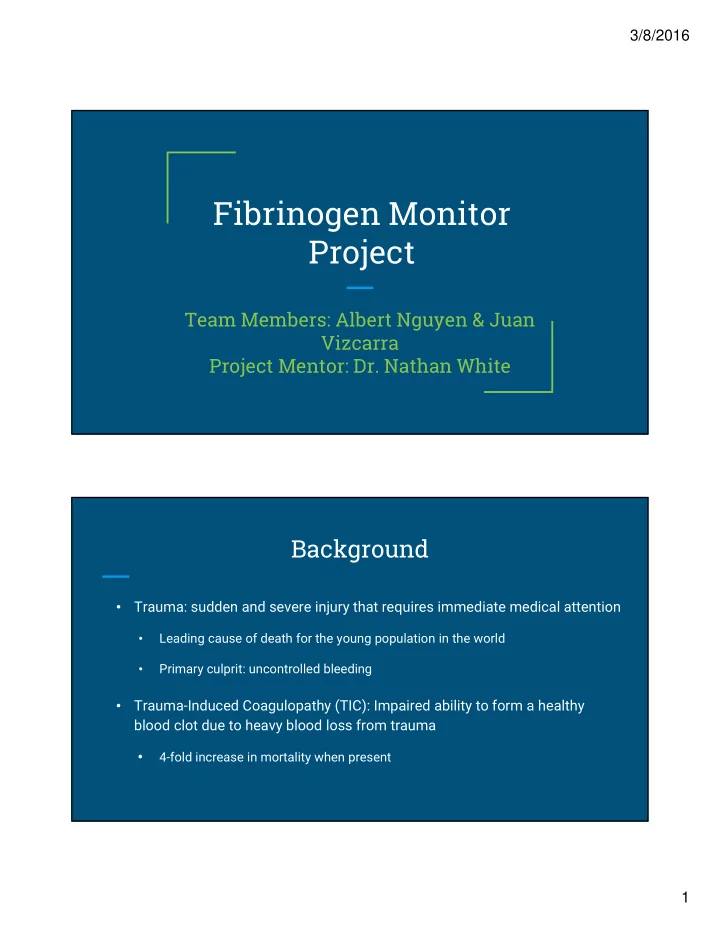

3/8/2016 Fibrinogen Monitor Project Team Members: Albert Nguyen & Juan Vizcarra Project Mentor: Dr. Nathan White Background Trauma: sudden and severe injury that requires immediate medical attention • Leading cause of death for the young population in the world • Primary culprit: uncontrolled bleeding • Trauma-Induced Coagulopathy (TIC): Impaired ability to form a healthy • blood clot due to heavy blood loss from trauma 4-fold increase in mortality when present • 1
3/8/2016 Background Current treatments? • administration of resuscitation fluids • Short timeframe for intervention • 50% of civilians hemorrhaging die • before reaching hospital 85% of military hemorrhaging die • before reaching surgery Background Consequences of Misdiagnosis ● Standard ● Coagulants rescucitation Coagulopathy? given fluids given No Yes Thrombosis or ● Patient bleeds to ● stroke death 2
3/8/2016 Background/Clinical Need? Role of Fibrinogen • releases fibrin monomers which leads to scaffold of clot • depletes first during trauma • shown to be strong indicator of coagulopathy • Current Limitations • Devices that too big, slow, and thus inaccessible for urgent trauma patients • Need • A point-of-care device that can access the quality of a clot quickly, reliably, and • in a portable manner Previous Capstone Designs Measurements: • Stiffness of clot • Turbidity • Ratio of two measurements correlated • with fibrinogen concentration Limitations: • Good PPP results, bad whole blood • results Correlation was not accurate enough • 3
3/8/2016 Design Specifications Aim: Design device to monitor clot structure and strength to determine • whether patient has coagulopathy Important Characteristics of Device • Quick response time • Portable • Reliable • Sturdy • Design Overview Proposed Design Bifurcation of sample into two • chambers Porosity test through a microfluidic • channel Mechaial strength test through a • cantilever approach Measurements give rise to new • hemostatic ratio 4
3/8/2016 Porosity Test Permeability/Porosity calculated • based on Darcy’s Law Calcuated after certain amount of • buffer flows through or certain pressure drop Fluid pump/sensor to regulate and • ����� � � ���: � = −�� � � − � � measure pressure μ� Mechanical Strength Test A B Idea based on AFM technology • C D Motion driven by solenoid • Custom designed silicone • cantilevers for increased sensitivity Segmented photodiode for detection • Δ������� = � � � � � − �� � � � � � Force-displacement measurements • D��������� = ������ ∗ ∆������� to approximate tensile modulus ����� = � ���������� ∗ ���������� 5
3/8/2016 Materials PBS buffer solenoid • • rubber tubing • linear variable differential transformer • glass pipets • segmented photodiode • pressure pump/sensor • laser light • porcine blood • collimator lenses • silicone rubber sheets • Resources: aluminum coating UW fabrication facility • • TEG & ROTEM (Harborview) 3D Printer – PDMS material • • Challenges Cantilever technology concerns: sensitivity • small size cantilevers are sensitive to thermal changes and small vibrations • initial loading might be damaging to cantilever • Device concern: connections of both technologies • Prorosity concerns: few past studies on desired scale and sample size • Time constraints • Building from the ground up, designing might be as far as we go • 6
3/8/2016 Present Tasks Recreate the porosity results from published work • smaller scale and shorter time frame • Building of cantilever set-up • designing the custom cantilevers • optimizing the size and arrangement of set-up • sensitivity testing to show its improvement from previous work • Porcine blood sample testing • Pig’s blood will be supplied by Dr. White’s Laboratory in Harborview • Deliverables Phase 1: • Prototype of device incorporating fluid channel and cantilever approach • Resolution data: Δ Voltage/ Δ [Fibrinogen] • Noise-effective control of mechanical strength test • Porosity measurements under 10 minutes • Phase 2: • Portable device that contains our two test mechanisms • Injected sample able to disperse into two test chambers • User friendly control and readout • Quick response time: 1-5 minutes • 7
3/8/2016 Criteria for Success At least 10-fold increase in sensitivity of mechanical strength test • Increased correlation of blood loss/[fibrinogen] • and the new ratio Testing methods effectively employed in the • millimeter scale Works effectively with whole blood samples • Thank you! Questions? 8
Recommend
More recommend